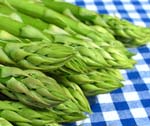Plant your asparagus now
Tom Coward explains how to get the most of creating a new asparagus border


The cold start to this spring has held things back, but now the weather is, at last, turning milder, we can start harvesting one of the finest delicacies the garden has to offer: fresh asparagus. This is a vegetable that has to be eaten straight from the garden to enjoy the full glory of its flavour, as it changes noticeably hours after harvest.
Try taking a spear of freshly cut asparagus and eat it immediately, raw, and you'll be amazed by its deliciously intense, sweet taste. At Gravetye, we always crop ours around midday, so that the spears are served as fresh as possible at lunchtime. The harvest will continue until mid June, but the biggest dis-advantage for asparagus is its relatively short season. Excess crop can be frozen and made into soups, but I prefer to make the most of the moment and eat it while the good times last.
Asparagus is easy to grow as long as you have well-drained soil, a sunny site and plenty of patience. On heavy ground, it can sulk for a few years before dying out, so if you're gardening on wet clay, making a raised bed of freely draining soil is usually the best solution.
April is the time for planting new stocks, and we're about to start some new beds in the kit-chen garden, so we can increase our yield. A good asparagus bed should be productive for more than 20 years, so it's important to prepare the ground well before plants go in. Any perennial weeds need to be eradicated and plenty of well-rotted manure must then be worked in to the soil. Before planting, a dusting of bonemeal fertiliser will give the young plants an extra boost.
Asparagus plants are either male, always producing the best crops, or female, which have beautiful little red berries in late summer and make excellent foliage plants for the border. They can be raised from seed, but it's best to buy one-year-old crowns from a nursery, which will be exclusively male plants. There are lots of good suppliers, but Blackmoor Nurseries, near Liss in Hampshire (01420 477978; www.blackmoor.co.uk) has always sent me good-quality plants, which arrive promptly by post.
* Subscribe to Country Life and save; Get the Ipad edition
The crowns are planted at the bottom of a 10in-deep trench, with the roots spread over a shallow ridge of soil and then just covered over. As the plants grow, the trench is gradually filled in, ensuring the best possible root system is established. Then comes the difficult bit-you have to wait for two years before you can start eating them! But patience always pays off in establishing a vigorous bed; it will produce generously for years to come.
Exquisite houses, the beauty of Nature, and how to get the most from your life, straight to your inbox.
Most of the work with an asparagus bed is in the initial establishment. Once mature, annual care consists of fertilising with Growmore or bonemeal in the spring, controlling the weeds, watering the bed when very dry, and cutting the fronds down in late autumn. We always harvest daily, cutting the spears about an inch below the ground when they reach 6in tall; we never take the spears from a plant for more than eight weeks, so that it can build up plenty of strength for next year's crop. Slugs can sometimes be a problem, but as asparagus is naturally a plant of sandy coastlines, it will tolerate a sprinkling of salt, which can be applied over the bed to dispose of them.
Growing a selection of early, mid and late varieties can help to extend the season. Gijnlim is a good early Dutch variety and Connover's Colossal is a brilliant mid-season cropper with good flavour. Guelph Millennium is probably the best late one, but I'm interested in trying a new variety called Pacific Purple.
There is a lot of literature about asparagus growing, but my favourite is Asparagus Culture, best methods employed in England and France, written in 1881 by our garden's founder, William Robinson. This is still available through Kessinger Legacy Reprints (www.kessinger.net) and a version is available to read online.
Although it's more than a century old, it was written at the height of Victorian perfectionism and these are plants that haven't changed very much in the intervening time.
* Follow Country Life magazine on Twitter
Country Life is unlike any other magazine: the only glossy weekly on the newsstand and the only magazine that has been guest-edited by His Majesty The King not once, but twice. It is a celebration of modern rural life and all its diverse joys and pleasures — that was first published in Queen Victoria's Diamond Jubilee year. Our eclectic mixture of witty and informative content — from the most up-to-date property news and commentary and a coveted glimpse inside some of the UK's best houses and gardens, to gardening, the arts and interior design, written by experts in their field — still cannot be found in print or online, anywhere else.
